We’ll have not one but many opportunities to enjoy a rare lineup of the bright planets over the next few weeks. Amazingly, they’ll be aligned in order of their distance from the Sun.
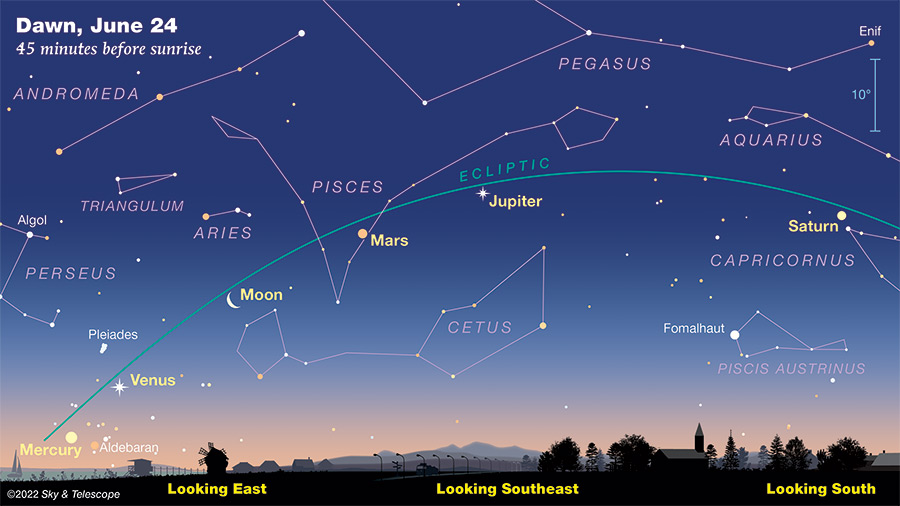
Sky & Telescope graphics
Like a peacock spreading its feathers, the solar system's five brightest planets will fan out in a beautiful display at dawn through early July. Even more amazing, they'll be in correct order outward from the Sun starting with Mercury at the eastern horizon followed by Venus, Mars, Jupiter, and ending at Saturn. Standing under the spread will feel like looking out the window of spaceship Earth at our place in the cosmic order.
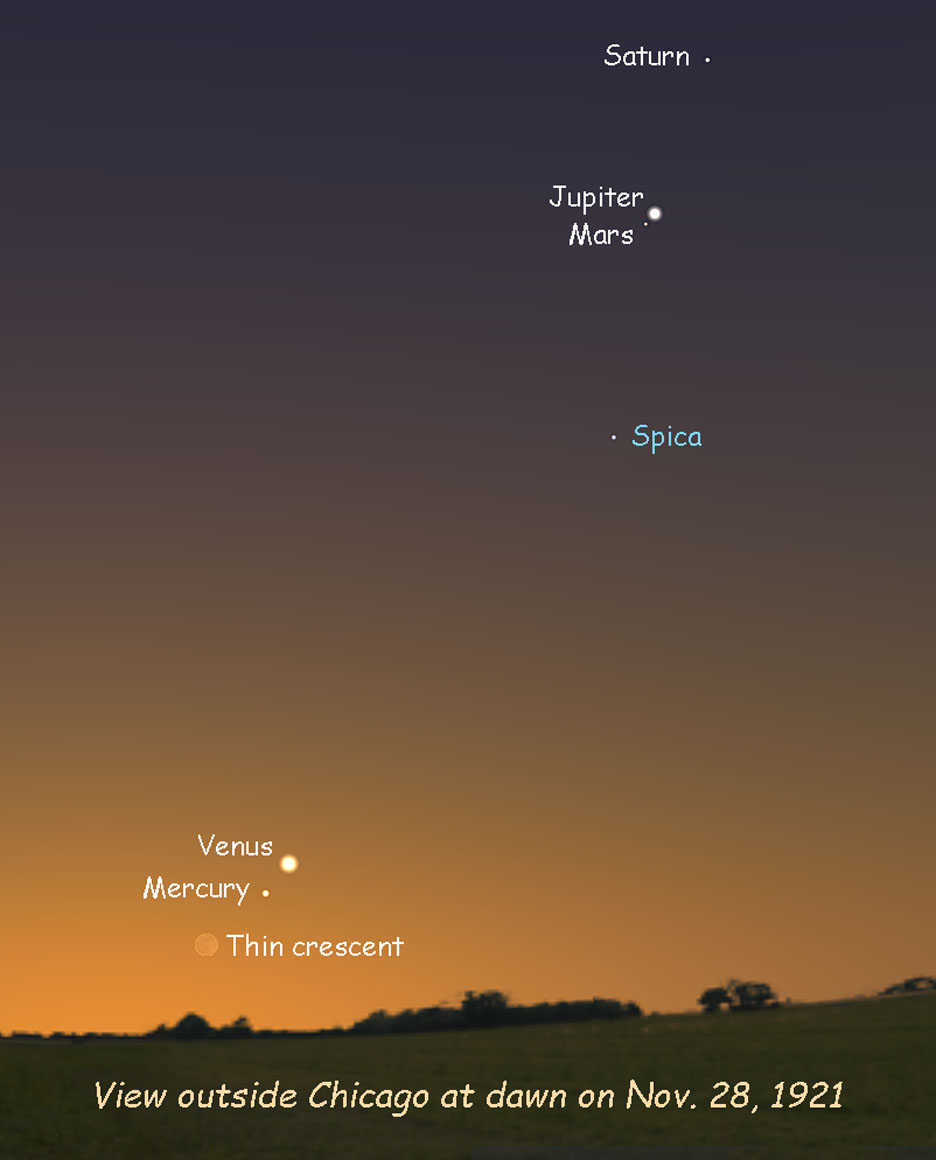
Stellarium
This rare event last occurred in the morning sky in December 2004. Turning to the evening sky, we saw similar planet lines in October 1997 and September 1995, but Mercury's elongation at those times was no more than 10°, restricting the view to sharp-eyed observers in tropical latitudes. For U.S. skywatchers the last similar grand spread took place in July 1957. Yikes, I was barely four years old!
Best dates
I encourage you to get up early at least one morning for a look. Invite friends. Bring the kids. There will be multiple opportunities for viewing, but the two choicest opportunities occur on June 24 (described above) and June 26, when Venus and the filament-thin Moon meet in conjunction. While it's not a once-in-a-lifetime event, the next opportunity won't be till March 2041. Call me impatient, but I'm not making any assumptions about the future.
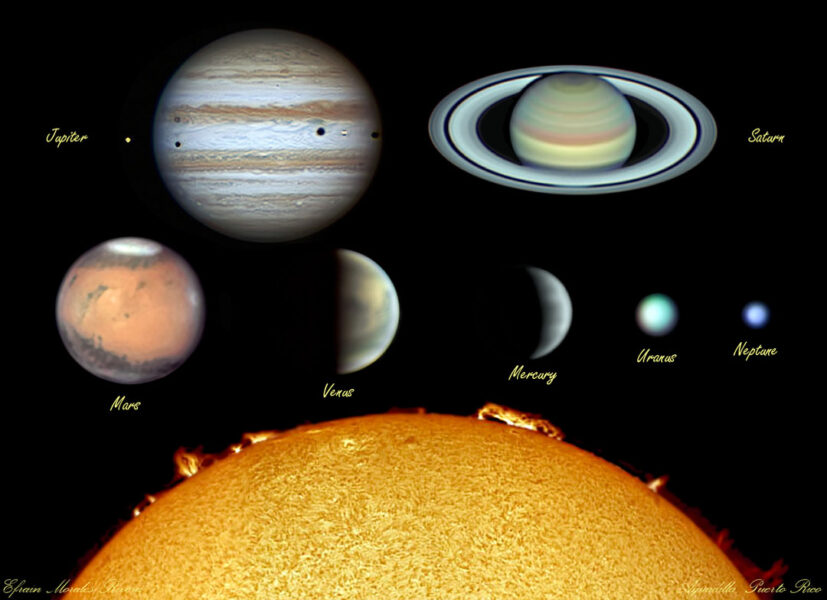
Efrain Morales
The alignment is essentially a naked-eye event — the only requirements are clear to partly cloudy skies and an unobstructed east-northeastern horizon. That said, I strongly recommend you bring a pair of binoculars to help in digging out Mercury, which will hover low in the solar glow just a few degrees above the horizon for mid-northern and mid-southern latitude observers. Assuming an open view and haze-free air I think you'll see Mercury without optical aid. But a backup glass will guarantee you won't be shorted a planet. The other four will be much easier to spot.
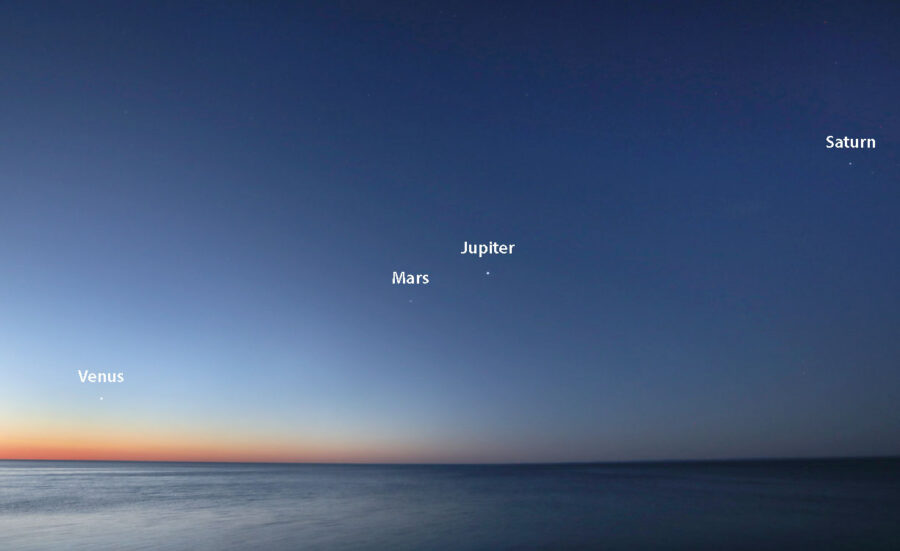
Bob King
You'll want to be outside a little early to get oriented and find a comfortable place to settle in for a view. An hour and 15 minutes before local sunrise is perfect. A lake, farmer's field, or a high lookout point with an unobstructed east-northeastern horizon makes an ideal location. Venus will be bright and low, with Mercury on the verge of rising at that time. All five planets will be best visible, depending on your latitude, from about 1 hour to 40 minutes before sunrise. Since that time is critical to planning, use this sunrise calculator to find out when the Sun comes up for your location.
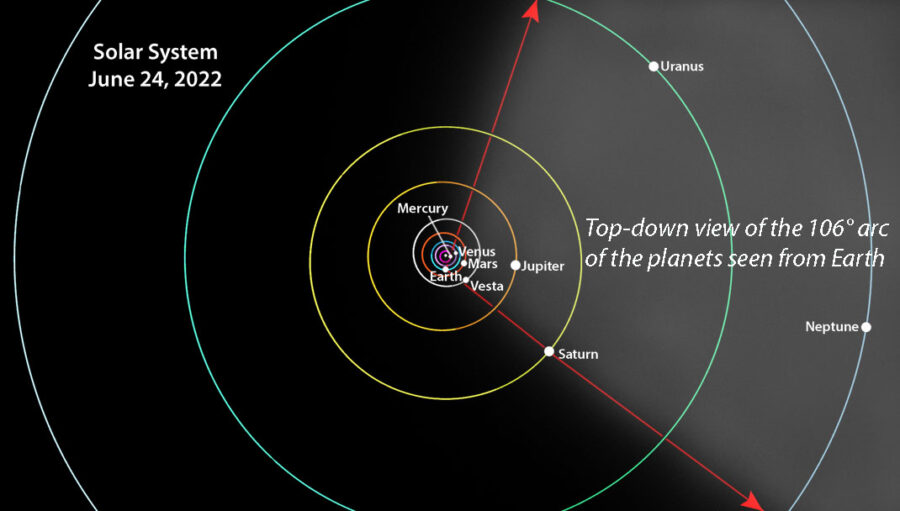
JPL HORIZONS with additions by Bob King
Photo tips
Since many of us will want to photograph the span, you may want to do advance reconnaissance to include suitable foreground scenery. On June 20th, the pack extends across about 102° of sky, increasing to 116° by month's end. For a full-frame DSLR camera, you'll need at least a 12- to 14-mm lens — with horizontal fields of view of 104° to 112°, respectively — to squeeze them all in. Cropped sensor cameras require even shorter focal lengths. Since these lenses don't come cheap, a better alternative would be to take several photos of the scene with a standard lens and combine them into a single image using an imaging program like Paint (packaged with Windows 10/11), Mac OS Photos, or Photoshop. Check YouTube for videos showing how it's done.
Your creative hand will also be needed during post-processing because of the wide difference in lighting between the darker southern sky, where Mars, Jupiter and Saturn reside, and the bright belly of the eastern horizon, where the inner planets hide.
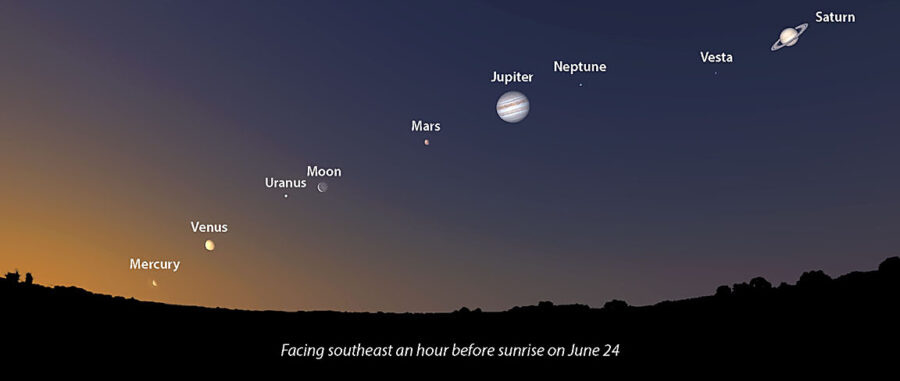
Stellarium with additions by Bob King
See every planet
Don't forget to include Earth in the lineup! You can do this by using the waning Moon as a proxy. Or just look around and admire the landscape. If you're a completist, you'll want to also search for Uranus and Neptune. They're up there, too, even if they screw up the order. Both are visible in either binoculars or a small telescope. And while we're at it let's include 4 Vesta, a representative from the main asteroid belt. Maps below provide the positions of these three additional objects.
How beautifully these five tiny lights demonstrate the essential flatness of the solar system. Looking up, you can practically see the ecliptic etched into the sky. When pointed out, even a neophyte will quickly grasp the "shape" of our neighborhood and Earth's place within it. And while flat Earthers will argue you to death about the sphericity of our planet or lack thereof, at least we can all agree this month that the solar system is as flat as a thin crust pizza.
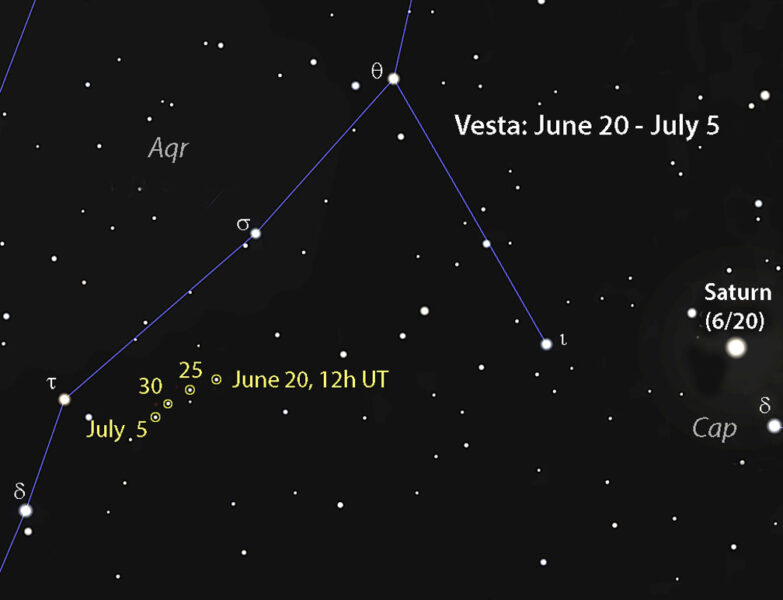
Stellarium with additions by Bob King
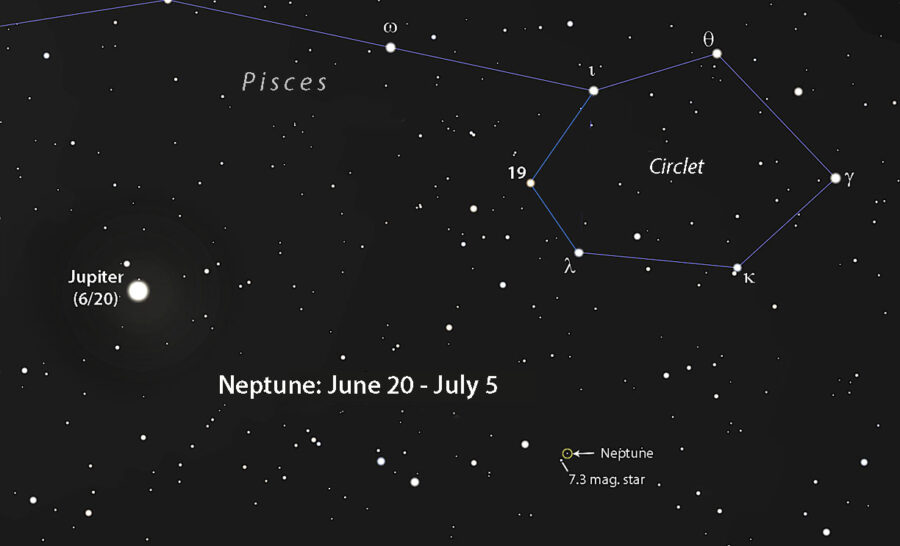
Stellarium with additions by Bob King
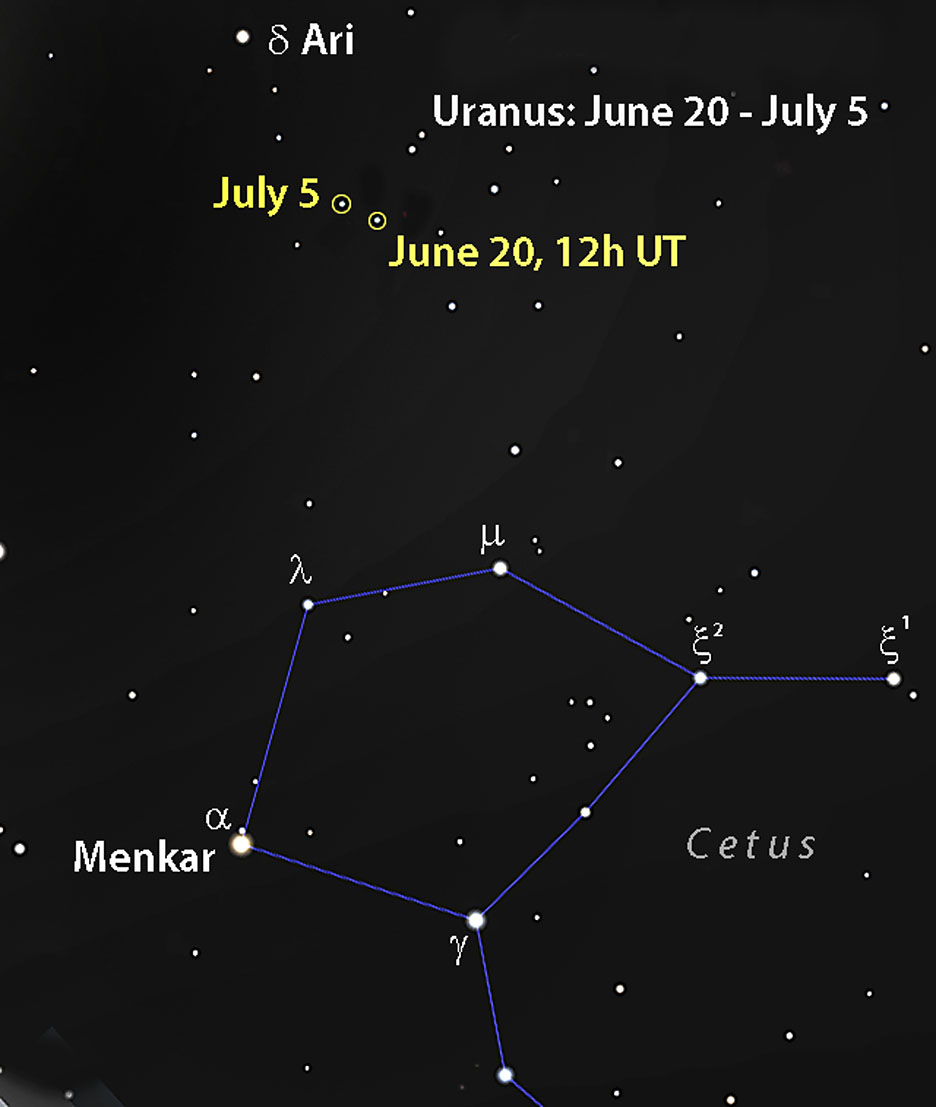
Stellarium with additions by Bob King
Read more about this and other celestial events this month in the June 2022 issue of Sky & Telescope.
 9
9









Comments
Rod
June 21, 2022 at 10:36 am
Very good. Some of us are viewing the planet alignments now in the early morning. Notes posted here, https://skyandtelescope.org/astronomy-news/observing-news/this-weeks-sky-at-a-glance-june-17-25-2/
You must be logged in to post a comment.
Bob KingPost Author
June 21, 2022 at 8:06 pm
Rod,
Good! Keep an eye on those orbs. All of them!
You must be logged in to post a comment.
Elena
June 25, 2022 at 1:28 pm
Dear Bob! I appreciate your clarification. I just started studying Astronomy
You must be logged in to post a comment.
bob kelly
June 21, 2022 at 7:52 pm
I made an iPhone video tour of four of the five planets (plus the Moon).
https://bkellysky2.wordpress.com/2022/06/20/early-morning-planet-video/
We had Elmsford-henge days with the full-Strawberry-super Moon when the Moon rise lined up with the Main Street in Elmsford, NY.
https://bkellysky2.wordpress.com/2022/06/13/hunting-the-supermoon/
https://bkellysky2.wordpress.com/2022/06/15/the-super-full-strawberry-moon-aligned-down-main-street/
You must be logged in to post a comment.
Bob KingPost Author
June 21, 2022 at 8:05 pm
Thanks, Bob — a busy week for the cosmos!
You must be logged in to post a comment.
Anthony Barreiro
June 22, 2022 at 4:11 pm
I scored my third bingo this morning. Saturn (plus Titan), Vesta, Neptune, Jupiter (plus the four Galilean moons), the Moon, Mars, Uranus, Venus, and Mercury. 10x42 binoculars, and a 60 mm f/5.5 refractor for Saturn and Jupiter. Mercury is finally bright enough to see with the unaided eye.
I would not have been able to find Vesta, Neptune, and Uranus from scratch all on the same morning. It always takes me a few tries. First I need to find the right place and familiarize myself with the layout of the brighter stars in the field of view. Then I need to make at least a couple of wrong guesses about which faint "star" is really a planet. Then, finally, one of those faint stars will have moved a little bit relative to the others. Bingo!
You must be logged in to post a comment.
Elena
June 25, 2022 at 11:12 am
Hello! What degree of sky must be between the planets to be considered a parade of planets? Is there a scientific interpretation of the parade of the planets?
You must be logged in to post a comment.
Bob KingPost Author
June 25, 2022 at 11:40 am
Hi Elena,
A "parade" is not an official term just an attempt at a colorful description of the scene, so there aren't specific qualifications. Sometimes a planet "parade" or line is much shorter. For instance, in 1921 they all fit along an arc just 44° long. Practically speaking, a planet lineup would be defined as seeing all the bright ones in the sky at the same time, so 180° or less.
You must be logged in to post a comment.
Rod
June 30, 2022 at 6:56 am
Okay, I observed some ducks in a row this morning in MD 🙂 [Observed 0445-0515 EDT (0845-0915 UT). Sunrise 0545 EDT (0945 UT) in Gemini. New Moon 29-June-2022 0252 UT. Easy viewing using 10x50 binoculars for Mars, Jupiter, Saturn. Neptune more difficult near 0445-0450 EDT. I could see Mars, Jupiter, Saturn, and the star Deneb Algedi below Saturn position in Capricornus, naked eyes and bright in the 10x50 binocular view. Stellarium 0.22.1 angle mode shows Saturn and Deneb Algedi separated by 1 degree, 36 arcminute, and 58.56 arcseconds or just about 97 arcminute angular separation in their sky positions. Mars, Jupiter, and Saturn make good telescope targets about 0400 EDT in my location. I did not setup and use my 90-mm refractor telescope this morning, just quick easy views using 10x50 binoculars. A stellar pattern 29 Psc, 27 Psc, 24 Psc, and 20 Psc is an easy 4-star asterism star hop into Neptune’s position in the sky. Neptune retrograde in Pisces 28-June-2022. Starry Night Pro Plus 8 Sky Calendar View states, “Neptune Enters Retrograde (pre-dawn) On Tuesday, June 28, the eastward prograde motion of the distant planet Neptune through the background stars of western Pisces will slow to a stop. After today it will commence a westward retrograde loop that will last until early December. In late June, Neptune’s faint, blue disk will be observable in telescopes in the lower part of the southeastern sky between about 2 and 4 a.m. local time. Retrograde loops occur when Earth, on a faster orbit closer to the sun, passes more distant planets “on the inside track”, making them appear to move backwards across the stars.” Neptune is now moving westward away from 20 Psc near the ecliptic as retrograde continues. Weather, clear skies, temperature 19C, winds calm. By 0510 EDT, the sky was brightening as sunrise approached. Near 0535 EDT, I checked Jupiter and could still see with naked eyes but growing much dimmer than earlier in the morning.]
You must be logged in to post a comment.
You must be logged in to post a comment.